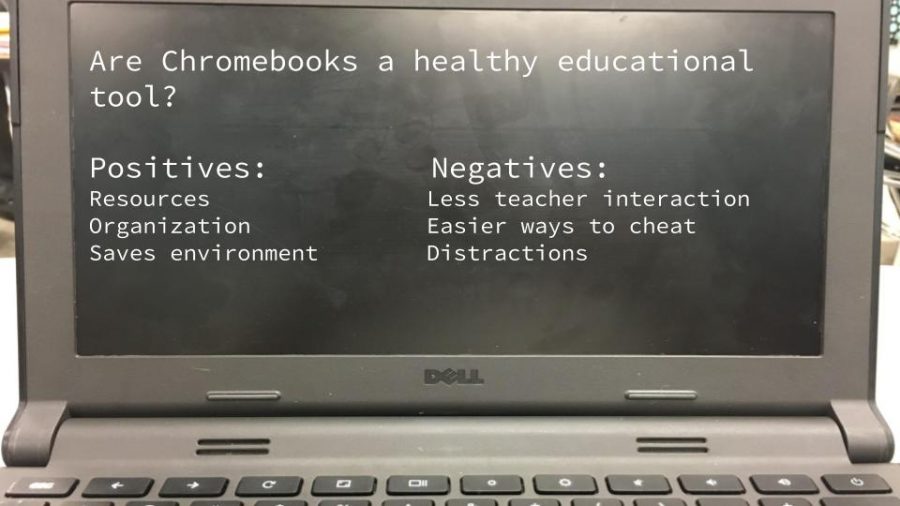1:1 Chromebooks improve learning but create headaches
October 25, 2017
Ever since 1:1 Chromebooks were introduced a year ago, they have taken over classrooms. Most students said “goodbye” to paper assignments and big clunky textbooks, and “hello” to Google Classroom and Google Drives.
After having the Chromebooks for a year, both students and teachers are getting better at using them. Students and teachers can now easily and quickly access their emails, drives, and online classrooms. Although Chromebooks have greatly helped learning in the classroom, all is not perfect.
The great news
Chromebooks are a learning tool for organization ease, a way of saving the environment, and a new way of learning.
Chromebooks are one of the easiest ways for students to organize and save their work from classes. It is easier for students to have one device rather than four folders with papers falling out everywhere. Most teachers also have a Google Classroom and use it to different degrees.
Mr. Sunkel, who teaches Biology and AP Environmental Science, has a very detailed Google Classroom. He has links to all of the student assignments and his power points. Students can keep track of the lessons that were taught in class; assignments are easy to turn in; and you can often see what you are expected to do in class that day. This creates a good way for students to keep track of the work they did in each class.
Class of 2020 member, Shannon Coggins, said, “Google Classroom keeps all of my documents for each specific class in one place.”
Chromebooks also have a plethora of learning tools for each subject. These websites include NoRedInk, Quizlet, Tenmarks, Online text book, and QuizIzz. These are just some tools that students can use in class. There is also a tool called the GAFE. This stands for Google Apps for Education. The GAFE is a way for students to learn or get better at a subject or unit. In 9th grade English classes teachers use NoRedInk. This is a great tool because it gives students a chance to work on grammar.
The computers also help save the environment. The amount of online assignments and tests eliminates the amounts of papers and copies teachers have to make. It is also easier for students to have their assignments online, rather than printed out. Chromebooks are also very affordable. The security deposit for each student is just $30 per semester.
“I like having the Chromebooks in class because I can easily write papers and turn them in.” Says class of 2020 student Kayla Freeman.
Chromebooks are not always the best tool
Although there are many positive things about Chromebooks, there are some frustrations, too. They can create less teacher interaction and new ways for students to cheat.
Students have started to become slaves to their computers. Teachers rarely ever sit down with students and talk about their work. This causes students to be dependent on their devices, and students are less likely to ask questions in the class. Studies from Andreas Schleicher, OECD director for Education and Skills, have shown that students that use devices in class have lower test scores due to the lack of teacher interaction and distractions.
Class of 2020 member, Gabbi Young, said, “It can get hard to try and separate using the Chromebook as a tool from using the Chromebook as something I rely on in class.”
Taking tests online can create easier ways for students to cheat. There is more access to online sources and different tabs where students can cheat when a teacher is not looking. All of the information a student could need for a test is sitting right in front of them.
Some students chose not to use one of the schools Chromebooks, and bring a device from home instead. Using a device from home can get difficult at times. Not all devices that students use from home have programs that the school devices have. For some students, having their own device is great because they don’t have to worry about returning it and keeping it in great condition.




AKA AKA • Apr 8, 2021 at 3:18 pm
i have a spliting headache
concerned citizen • Oct 27, 2019 at 1:11 pm
can families choose an education with printed materials and 100% technology free ?